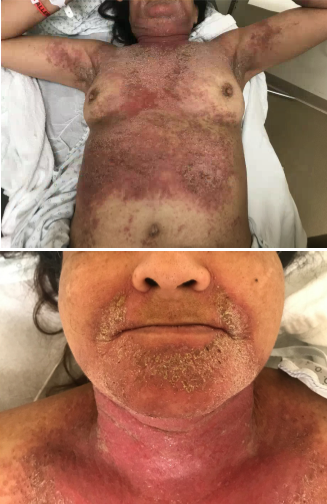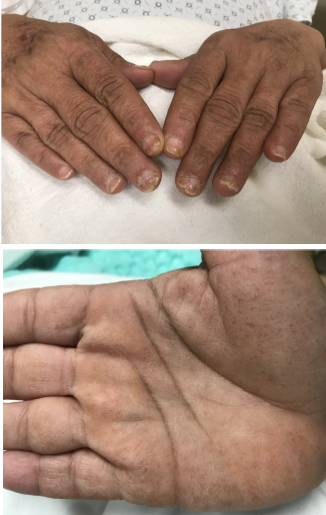Case Presentation: Darier disease (keratosis follicularis) is a rare autosomal dominant genodermatosis due to ATP2A2 gene mutation. Presentation includes a characteristic eruption in seborrheic regions exacerbated by sun exposure, heat, and secondary infection. The disease runs a remittent course beginning in puberty. Darier disease is associated with neuropsychiatric disorders including intellectual disability, seizures, mood disorders and schizophrenia. Recognizing Darier disease is important because it may be mistaken for other more common dermatologic diseases.A 57 year old woman with a history of asthma presented with a one month history of painful, pruritic rash. The eruption started in the groin and spread proximally to the neck, chest, scalp, axillae, and inframammary folds. Physical exam revealed eroded, erythematous plaques with overlying golden crust and peripheral vesicles on her chest, neck, scalp, and groin. Nail exam revealed longitudinal erythronychia, distal onycholysis, and notching of the distal nail plate. Palmar pits and punctate palmar keratoses were present. The patient had been hospitalized multiple times for a similar rash in the past and had been variably diagnosed with eczema, psoriasis, and zoster. Family history revealed two first degree relatives with similar rashes thought to be eczema.On admission, laboratory evaluation showed leukocytosis. Biopsies revealed intraepidermal vesicles with acantholytic dyskeratosis and hyperkeratosis, sparse dermal lymphocytic infiltrate, and numerous superficial neutrophils and bacterial forms. Based on biopsy and clinical findings, a diagnosis of Darier disease with secondary impetiginization was made. She was started on oral acitretin, triamcinolone ointment, oral cephalexin, and bleach baths. It was recommended she avoid clothing and environments that lead to sweating or excess moisture. Counseling was provided regarding the autosomal dominant nature of the disease. She began to improve with this therapy and was discharged with outpatient dermatology follow up.
Discussion: This patient presented with pathognomonic findings of Darier disease that had been previously undiagnosed. Darier disease should be suspected in patients who present with chronic exacerbations of painful, pruritic rash provoked by heat exposure in seborrheic areas including the forehead, scalp, nasolabial folds, lateral aspects of the neck, groin, and inframammary folds in women. Characteristic nail findings include red and white longitudinal bands with distal V-shaped nicking. Mucosal cobblestoning and punctate palmoplantar papules and pits are common. Family history may demonstrate autosomal dominant transmission. Biopsy illustrates suprabasal acantholysis and dyskeratosis. Due to the epidermal disruption, superinfection with bacteria or herpes can occur. Topical and oral retinoids are mainstays of treatment.
Conclusions: This case highlights the importance of recognizing key features of Darier disease and how it can be differentiated from commonly seen dermatologic diseases seen by internists and family practitioners.


